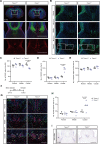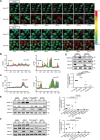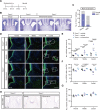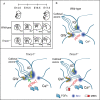Ca2+ homeostasis maintained by TMCO1 underlies corpus callosum development via ERK signaling
- PMID: 35927240
- PMCID: PMC9352667
- DOI: 10.1038/s41419-022-05131-x
Ca2+ homeostasis maintained by TMCO1 underlies corpus callosum development via ERK signaling
Abstract
Transmembrane of coiled-coil domains 1 (TMCO1) plays an important role in maintaining homeostasis of calcium (Ca2+) stores in the endoplasmic reticulum (ER). TMCO1-defect syndrome shares multiple features with human cerebro-facio-thoracic (CFT) dysplasia, including abnormal corpus callosum (CC). Here, we report that TMCO1 is required for the normal development of CC through sustaining Ca2+ homeostasis. Tmco1-/- mice exhibit severe agenesis of CC with stalled white matter fiber bundles failing to pass across the midline. Mechanistically, the excessive Ca2+ signals caused by TMCO1 deficiency result in upregulation of FGFs and over-activation of ERK, leading to an excess of glial cell migration and overpopulated midline glia cells in the indusium griseum which secretes Slit2 to repulse extension of the neural fiber bundles before crossing the midline. Supportingly, using the clinical MEK inhibitors to attenuate the over-activated FGF/ERK signaling can significantly improve the CC formation in Tmco1-/- brains. Our findings not only unravel the underlying mechanism of abnormal CC in TMCO1 defect syndrome, but also offer an attractive prevention strategy to relieve the related agenesis of CC in patients.
© 2022. The Author(s).
Conflict of interest statement
The authors declare no competing interests.
Figures






Similar articles
-
TMCO1 Is an ER Ca(2+) Load-Activated Ca(2+) Channel.Cell. 2016 Jun 2;165(6):1454-1466. doi: 10.1016/j.cell.2016.04.051. Epub 2016 May 19. Cell. 2016. PMID: 27212239
-
TMCO1 is essential for ovarian follicle development by regulating ER Ca2+ store of granulosa cells.Cell Death Differ. 2018 Sep;25(9):1686-1701. doi: 10.1038/s41418-018-0067-x. Epub 2018 Feb 21. Cell Death Differ. 2018. PMID: 29467381 Free PMC article.
-
iASPP suppresses Gp78-mediated TMCO1 degradation to maintain Ca2+ homeostasis and control tumor growth and drug resistance.Proc Natl Acad Sci U S A. 2022 Feb 8;119(6):e2111380119. doi: 10.1073/pnas.2111380119. Proc Natl Acad Sci U S A. 2022. PMID: 35121659 Free PMC article.
-
TMCO1 deficiency causes autosomal recessive cerebrofaciothoracic dysplasia.Am J Med Genet A. 2014 Feb;164A(2):291-304. doi: 10.1002/ajmg.a.36248. Epub 2013 Nov 5. Am J Med Genet A. 2014. PMID: 24194475 Review.
-
Craniofacial dysmorphism, skeletal anomalies, and impaired intellectual development syndrome-1 in two new patients with the same homozygous TMCO1 variant and review of the literature.Eur J Med Genet. 2023 Mar;66(3):104715. doi: 10.1016/j.ejmg.2023.104715. Epub 2023 Jan 25. Eur J Med Genet. 2023. PMID: 36708876 Review.
Cited by
-
TMCO1 is upregulated in breast cancer and regulates the response to pro-apoptotic agents in breast cancer cells.Cell Death Discov. 2024 Oct 1;10(1):421. doi: 10.1038/s41420-024-02183-0. Cell Death Discov. 2024. PMID: 39353922 Free PMC article.
-
Restoring carboxypeptidase E rescues BDNF maturation and neurogenesis in aged brains.Life Med. 2023 Apr 11;2(2):lnad015. doi: 10.1093/lifemedi/lnad015. eCollection 2023 Apr. Life Med. 2023. PMID: 39872114 Free PMC article.
-
ER Ca2+ overload activates the IRE1α signaling and promotes cell survival.Cell Biosci. 2023 Jul 3;13(1):123. doi: 10.1186/s13578-023-01062-y. Cell Biosci. 2023. PMID: 37400935 Free PMC article.
-
Acacetin reduces endoplasmic reticulum stress through the P-eNOS/PERK signaling pathway to attenuate MGO-induced vascular endothelial cell dysfunction.FEBS Open Bio. 2025 May;15(5):793-809. doi: 10.1002/2211-5463.70004. Epub 2025 Feb 10. FEBS Open Bio. 2025. PMID: 39927486 Free PMC article.
-
The relationship between TMCO1 and CALR in the pathological characteristics of prostate cancer and its effect on the metastasis of prostate cancer cells.Open Life Sci. 2024 Oct 29;19(1):20220972. doi: 10.1515/biol-2022-0972. eCollection 2024. Open Life Sci. 2024. PMID: 39479348 Free PMC article.
References
-
- Gerhard B, Elżbieta P-P, Richard B, Iris U, Giorgi K. Corpus callosum and epilepsies. J Epileptol. 2013;21:89–104. doi: 10.1515/joepi-2015-0008. - DOI
Publication types
MeSH terms
Substances
LinkOut - more resources
Full Text Sources
Molecular Biology Databases
Miscellaneous

